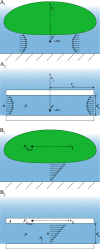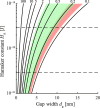Tree frog attachment: mechanisms, challenges, and perspectives
- PMID: 30154908
- PMCID: PMC6107968
- DOI: 10.1186/s12983-018-0273-x
Tree frog attachment: mechanisms, challenges, and perspectives
Abstract
Tree frogs have the remarkable ability to attach to smooth, rough, dry, and wet surfaces using their versatile toe pads. Tree frog attachment involves the secretion of mucus into the pad-substrate gap, requiring adaptations towards mucus drainage and pad lubrication. Here, we present an overview of tree frog attachment, with focus on (i) the morphology and material of the toe pad; (ii) the functional demands on the toe pad arising from ecology, lifestyle, and phylogenetics; (iii) experimental data of attachment performance such as adhesion and friction forces; and (iv) potential perspectives on future developments in the field. By revisiting reported data and observations, we discuss the involved mechanisms of attachment and propose new hypotheses for further research. Among others, we address the following questions: Do capillary and hydrodynamic forces explain the strong friction of the toe pads directly, or indirectly by promoting dry attachment mechanisms? If friction primarily relies on van der Waals (vdW) forces instead, how much do these forces contribute to adhesion in the wet environment tree frogs live in and what role does the mucus play? We show that both pad morphology and measured attachment performance suggest the coaction of several attachment mechanisms (e.g. capillary and hydrodynamic adhesion, mechanical interlocking, and vdW forces) with situation-dependent relative importance. Current analytical models of capillary and hydrodynamic adhesion, caused by the secreted mucus and by environmental liquids, do not capture the contributions of these mechanisms in a comprehensive and accurate way. We argue that the soft pad material and a hierarchical surface pattern on the ventral pad surface enhance the effective contact area and facilitate gap-closure by macro- to nanoscopic drainage of interstitial liquids, which may give rise to a significant contribution of vdW interactions to tree frog attachment. Increasing the comprehension of the complex mechanism of tree frog attachment contributes to a better understanding of other biological attachment systems (e.g. in geckos and insects) and is expected to stimulate the development of a wide array of bioinspired adhesive applications.
Keywords: Attachment organ; Bioadhesion; Biomimetics; Biotribology; Capillary adhesion; Drainage; Litoria caerulea; Lubrication; Toe pad; van der Waals.
Conflict of interest statement
Not applicable.Not applicable.The authors declare that they have no competing interests.Springer Nature remains neutral with regard to jurisdictional claims in published maps and institutional affiliations.
Figures











Similar articles
-
Force-transmitting structures in the digital pads of the tree frog Hyla cinerea: a functional interpretation.J Anat. 2018 Oct;233(4):478-495. doi: 10.1111/joa.12860. Epub 2018 Aug 19. J Anat. 2018. PMID: 30123974 Free PMC article.
-
Design of Tree-Frog-Inspired Adhesives.Integr Comp Biol. 2020 Oct 1;60(4):906-918. doi: 10.1093/icb/icaa037. Integr Comp Biol. 2020. PMID: 32413122 Free PMC article. Review.
-
Wet but not slippery: Boundary friction in tree frog adhesive toe pads.J R Soc Interface. 2006 Oct 22;3(10):689-97. doi: 10.1098/rsif.2006.0135. J R Soc Interface. 2006. PMID: 16971337 Free PMC article.
-
Estimating the maximum attachment performance of tree frogs on rough substrates.Bioinspir Biomim. 2019 Feb 1;14(2):025001. doi: 10.1088/1748-3190/aafc37. Bioinspir Biomim. 2019. PMID: 30706849
-
Tree frog adhesion biomimetics: opportunities for the development of new, smart adhesives that adhere under wet conditions.Philos Trans A Math Phys Eng Sci. 2019 Jul 29;377(2150):20190131. doi: 10.1098/rsta.2019.0131. Epub 2019 Jun 10. Philos Trans A Math Phys Eng Sci. 2019. PMID: 31177956 Free PMC article. Review.
Cited by
-
Micro-Nano Hierarchical Structure Enhanced Strong Wet Friction Surface Inspired by Tree Frogs.Adv Sci (Weinh). 2020 Aug 9;7(20):2001125. doi: 10.1002/advs.202001125. eCollection 2020 Oct. Adv Sci (Weinh). 2020. PMID: 33101853 Free PMC article.
-
Why link diverse citizen science surveys? Widespread arboreal habits of a terrestrial amphibian revealed by mammalian tree surveys in Britain.PLoS One. 2022 Jul 6;17(7):e0265156. doi: 10.1371/journal.pone.0265156. eCollection 2022. PLoS One. 2022. PMID: 35793361 Free PMC article.
-
From Dry to Wet, the Nature Inspired Strong Attachment Surfaces and Their Medical Applications.ACS Nano. 2025 Mar 18;19(10):9684-9708. doi: 10.1021/acsnano.4c17864. Epub 2025 Mar 6. ACS Nano. 2025. PMID: 40051147 Free PMC article. Review.
-
Epidermal microstructures on the paired fins of marine sculpins suggest new functional hypotheses supporting benthic station-holding.R Soc Open Sci. 2025 Mar 5;12(3):241965. doi: 10.1098/rsos.241965. eCollection 2025 Mar. R Soc Open Sci. 2025. PMID: 40420848 Free PMC article.
-
Polar bear paw pad surface roughness and its relevance to contact mechanics on snow.J R Soc Interface. 2022 Nov;19(196):20220466. doi: 10.1098/rsif.2022.0466. Epub 2022 Nov 2. J R Soc Interface. 2022. PMID: 36321372 Free PMC article.
References
-
- Peattie AM. Functional demands of dynamic biological adhesion: an integrative approach. J Comp Physiol B. 2009;179:231–9. - PubMed
-
- Gorb SN. Biological attachment devices: exploring nature’s diversity for biomimetics. Phil Trans R Soc A. 2008;366:1557–74. - PubMed
-
- Niewiarowski PH, Stark AY, Dhinojwala A. Sticking to the story: outstanding challenges in gecko-inspired adhesives. J Exp Biol. 2016;219(7):912–9. - PubMed
-
- Gorb S, editor. Attachment Structures and, Adhesive Secretions in Arachnids. vol. 7. Cham, Switzerland: Springer; 2016.
Publication types
LinkOut - more resources
Full Text Sources
Other Literature Sources
Miscellaneous

